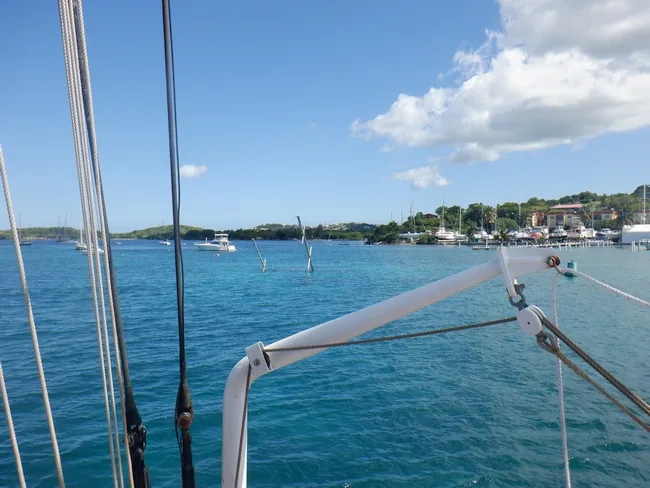News
Opportunities for Artificial Reefs in St. Croix

Author: Nadia Racz and Natalie Rotondo,Saint Michael’s College and The University of Rhode Island
Ship’s Log
Ship’s Position
17°48.222’N x 064°20.513’W
Ship Heading
180
Ship Speed
4.6 knots
Taffrail Log
195.6 nm
Weather
F4 winds ExS, 5ft waves
Location
13 nm East of St. Croix
Today, we will be talking about potential artificial reefs in St. Croix, USVI. In our Ocean Science and Public Policy course during the onshore component in Woods Hole we wrote a policy brief on the frameworks of installing artificial reefs in the US Virgin Islands. Then when we headed to St. Croix, we talked with local researchers at the East End Marine Park about the impact of artificial reefs on St. Croix’s marine protected areas.
Our findings on the effectiveness of artificial reefs were like the findings of the researchers in St. Croix. It was stated that these inorganic reefs, if implemented correctly and safely, are beneficial to the biodiversity, fish stocks, and coral cover on existing reefs.
In Christiansted Harbor on the day of our departure, using the skills from our Human Census data collection we noticed a half sunken sailing vessel. We took note of the fact that it could be an effective artificial reef if located in a different area. From the research in our policy brief we walked through some of the aspects of artificial reef making so that it could be a safe and thriving reef structure. A boat that was sunken accidentally like this one did not go through the process of making it safe beforehand. There were likely harmful materials on the boat that would not make it great for an artificial reef. It is also placed in the middle of a busy harbor serving as a navigational hazard. The reason that we noticed the sunken ship is because of its masts still sticking out of the water.
The ship could be removed, and the harmful materials could be taken out of it and it relocated to another site to be a more beneficial artificial reef. When we brought this up, our Captain Kevin brought up that the boat owner had to pay a fine. That fine would most likely be less money than it would cost to go through the removal process. The harbor could choose to remove it themselves after the fine has been paid.
We have studied six pre-existing reefs in the U.S. Virgin Islands. The sad reality is that the reefs are dying due to disease and many other factors. We know from our research that reefs provide many services not only to the ocean ecosystem but to humans. These island locals depend on reefs for tourism because it is one of their many industries and provides a large source of income. These reefs also provide a barrier for erosion along the coastline. With these reefs dying, these services are diminishing. We believe if the USVI implemented artificial reefs into their plans on how to sustain reefs, there would be a substantial benefit for natural resources and human uses. Although this form of restoration can be costly, it is a solution that has proven to work. There are other ways that we can sustain coral reefs, but we believe that introducing artificial reefs is one of the most effective forms of restoration for our reefs and coastlines. There are many steps that must take place to make artificial reefs an effective tool.
There must be regulations on what is viewed as an artificial reef and it must be inspected as a safe material. This will make sure that companies do not just put trash in the ocean and claim that it could be an artificial reef. We also must study the site we wish to place a reef. We should first focus our attention on sites at risk for erosion. Then study the existing habitat and make sure to not disturb any healthy coral structures in the process. Once the research has been done, we can then safely place a reef hopefully providing a place for corals to grow and thrive and for locals to continue sustaining themselves for generations to come.
– Nadia Racz, Saint Michael’s College, C watch and
– Natalie Rotondo,The University of Rhode Island, C watch
Contact: Douglas Karlson, Director of Communications, 508-444-1918 | [email protected]